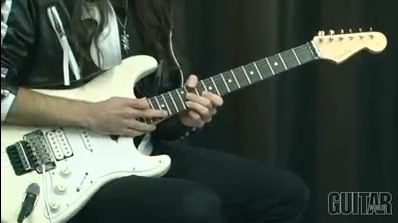Hybrid Picking in Three Easy Steps!

As time progresses, guitar playing is pushed to new limits, introducing elements that challenge our dexterity, agility, stamina and perseverance.
With unique approaches to picking as well as practice routines, we are able to evolve and create our own styles of playing.
In this column and video, I'd like to initiate what is called hybrid picking. Hybrid picking is a technique focused on the use of the pick and fingers associated with your picking hand.
Hybrid picking is most beneficial if broken down into three helpful patterns:
Figure 1: Descending pentatonic run used over an A chord
Figure 2: An Am pentatonic (A, C, D, E, G) run focusing on two strings
Figure 3: An Am pentatonic run focusing on two strings with change of taking it through the scale.
Each pattern is designed to be isolated and practiced with a metronome. (Remember, when using a metronome, to start slow in a comfortable tempo gradually increasing the speed to your liking).
Some things to take into account when practicing hybrid picking is the tone. Practicing with a clean tone will help decrease any unwanted distortion. When distorted, lightly muting the strings with your pick hand can help avoid any unwanted noise that can be created. Keep in mind when muting it is best not to push or clamp too hard on the strings, which can damper the notes you are trying to play.
All the latest guitar news, interviews, lessons, reviews, deals and more, direct to your inbox!
Figure 1
The most beneficial way to approach this is to break it down into sections. First, start with the A note on the high E string. Pluck the high A note on the E string with your middle finger. (You will see that all plucked notes with your middle finger are marked with a ( * ) notation in examples given). Keep in mind that in this measure there is a use of the flat 5 from your A blue scale (A, C, D, E, Eb, G).
The Eb note is picked with a downstroke alternating to an upstroke on the D note, ultimately pulling-off to your C note on the 5th fret G string. In measure 2 of Figure 1 all picked notes are best executed with a downstroke and incorporates the major 3rd (Csharp note). The lick continues on and is repeated in the lower octave.
Dave Nassie
The next upstroke motion comes on the G note at the beginning of measure 3. The following two notes will be alternated, however you will pull-off from Eb to D and slide down to your C note on the 5th string 3rd fret.
Figure 2
This figure is one of my favorite warm-up patterns which I find effective when incorporating the middle finger of your pick hand. It is an isolated pattern, taken from Figure 3 designed to introduce you to Figure 3’s full pattern.
Remember when practicing this run to be conscious of palm muting and any excess string noise that may occur.
Start with a down-stroke motion on the G note (fourth string). Every note played on the third string or G (string) is plucked with the middle finger of your pick hand.
Typically, the most difficult part of this example is cleanly rolling your ring finger of your fretting hand from the A note on the fourth string to the D note on the third string without creating unwanted overtones from the third string. Practicing this run with a clean tone will alleviate problems in the early stages of mastering this phrase.
Figure 3
When practicing this run, it is best to start slow with the metronome, gradually increasing your speed and tempo.
Figure 3 conveys how the basic pattern or idea can be carried out in position 1 of the A minor pentatonic scale (A, C, D, E, G).
With transferring the pattern from Figure 2 throughout the scale, please note that each section starts with a down-stroke using your picking hand.
- When playing the b5 from the A blues scale (A, C, D, E, Eb, G) you will notice some dissonance between the intervals created in the pattern. Starting at a slow tempo will allow the sound to take on a distinctly different dynamic as opposed to a better sound at a
- faster tempo.
Hybrid picking is a fantastic way to improve the scope of motion with your pick hand, enabling your ability to play patterns and runs that often at times can be difficult when relying on an alternating motion with the pick. The tone achieved from the use of another finger on the pick hand offers a great change of pace from that of just using the pick alone and can unfold new objectives when improvising.
The examples disseminated in this column, in concordance to time and practice, I have all found to be beneficial in many musical situations.
Dave Nassie is a current resident of Huntington Beach, California whom started playing guitar
at the age of nine and began teaching at 14 at the Antmann School of Music. His studies of
guitar took place at local schools in Orange County California where he focused on theory and
technique studies. He has played for bands such as Infectious Grooves, No Use For A Name,
Bleeding Through, and Throwdown and has filled in on base for Suicidal Tendencies.
When not on tour, Dave does several clinics and guest sessions at schools throughout the world,
as well as developing strong presents on the web with lesson tutorials. He is a sought out guitar
instructor with over 26 years of experience whom teaches beginners to established music industry
touring artists while incorporating Skype, FaceTime and Youtube.
With the web being readily available, Dave has given thousands of lessons over Skype from all
parts of the world which allo
